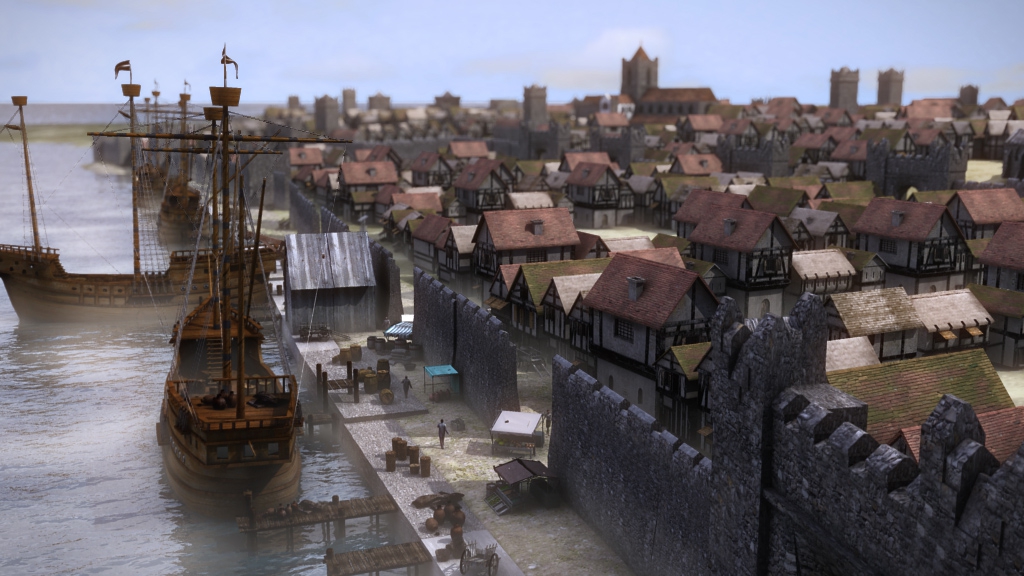In late medieval times, walled Dublin was very small, confined to the area between Merchant’s Quay and Wood Quay and inland for 300-400 metres to include the area around Christ Church and Dublin Castle. Dublin had suburbs outside the walls, along today’s Dame Street to College Green, around St Patrick’s Cathedral, along Thomas Street and James’s Street, and across the Liffey in Oxmantown.
Dublin had a notorious hygiene problem caused by human and animal waste. Henry VII learned that “pestilential exhalations†hung over his city of Dublin, preventing his administrators reaching Dublin Castle and visitors coming to the city. In the early 16th century Dublin city authority continued to fight a losing battle with the disposal of waste.
Late medieval Dublin had an impressive water supply service set up in about 1250, by which the river Poddle, re-energised by water diverted from the Dodder, delivered 2.7 million litres into the city every day. While the supply was regularly under threat from polluting animals and fishers who interfered with the water course, it was patrolled by bailiffs and overall it worked well.
The Liffey estuary and Dublin bay was always badly silted and ships setting out from the quays to sail to Chester found it tricky to get out of the estuary and the bay until they had “clear road†at Poolbeg. The problem was never solved until ships’ berthage was moved east of the city in modern times.
Most job opportunities came from the craft guilds – training for a boy or girl over seven years leading to qualification in a craft such as merchant, miller, tailor, sadler, butcher, smith or tanner. Training in about 50 such trades was available in Dublin provided the apprentice could pay the registration fees. Not to diminish the crafts which needed both manual dexterity and intelligence, other work could be done that was more intellectually-based – clerk, secretary, scribe, legal notary, lawyer, clergyman. To enter these employments required education in Dublin where there were very few schools, or education abroad in an English university. In both cases a prerequisite was family financial support.
Without a recognised skill one could work occasionally as a labourer, but there was the danger of falling through the social net and relying on begging. These beggars were not welcome in Dublin (beggars specifically being named as persons who must leave the city). Those in serious poverty could enter the hospital of St John near Thomas Street, the institute having 113 beds in 1373 and 50 beds in 1539.
In business, everyone had debtors and creditors and agreed a date of settlement. If a dispute arose, merchants had access to a merchants’ court where quick decisions were made by the justice often within an hour of the disputants entering the court. These courts were called pie powder courts (pie poudré, French) or “dusty feet†courts, a reminder that those who used the court were busy merchants on the move who had come into court off the street in their travelling clothes.

Final settlements with debtors and creditors came at the time of death when one’s will was processed. Debtors and creditors would normally reside 5-10km from the testator, but may have been located 15km distant. At his death, John Mold of Malahide had debts to pay across the Irish Sea in Conway (Wales) and in Bristol.
Late medieval Dublin had a symbiotic relationship with Chester, Dublin merchants bringing goods to the city in the mid-15th and early-16th century. Dublin exported skins, hides, fish and textiles to Chester and brought back local salt and continental goods. Merchants frequently sailed for Chester, but also regularly used factors or on-board agents to bring their goods across the Irish Sea. John Wilkynson was such a person, working for 25 merchants out of Dublin, Howth and Drogheda, making 39 agreements with them, and sailing 5,000 miles in one year. Christina Clerke also worked as a factor out of Dublin and sailed over 1,000 miles in a year.
Trade in Dublin was regulated by the city’s authority so that everyone involved would make a reasonable profit and that the system would be fair to all. The authority also concerned itself with maintaining standards of hygiene in the fish and meat trade, and in particular with the regulation of supplies of ale, cereals, fish and meat. The authority’s greatest fear was that the city, largely occupied by non food-producers, would run short of cereals in winter. On occasions, it was forced to search barns in the city to find stockpiles of grain and put them on the market to avoid famine in the city.
The traditional church was loved by the laity, despite the strict regime in which sinners were publicly denounced on Sundays and those who ignored the church in legal matters were excommunicated. Church authorities visited monasteries and convents and pointed out their failings. While expensive indulgences were occasionally preached, at parish level income from indulgence offerings seems to have been modest enough. There was a long tradition in the medieval church of devotion to Our Lady and of praying to her as an intermediary. The laity regarded as most sacred the moment of consecration in the Mass and were capable of developing a personal relationship with the crucified Christ.
The church changed most significantly in the late medieval period – the laity could arrange for Masses to be said with their chosen selection of readings, at times and for reasons required by their lay religious group (chantry), and lay proctors (churchwardens) were elected by the laity at parish level to run the parish in all material matters. In the late medieval period, the laity began to pray before images of saints rather than solely before relics as heretofore.
When the Reformation came to Dublin in the late 1530s, offerings at shrines were stolen by the state (£500,000 in today’s money) in Dublin city and county, monasteries were closed and buildings, lands and leases were confiscated and redistributed. Government officers sought and received monastic buildings at Celbridge, Grace Dieu and Holmpatrick, Co Dublin. Some monastic buildings were used by lawyers (King’s Inns) and for the storage of munitions. Liturgical books were censored, references to relics, Thomas Becket and the Pope being excised.
Source : Social Life in Pre-Reformation Dublin, 1450-1540 by Peadar Slattery is published by Four Courts Press.
Extracts from The Irish Times.

